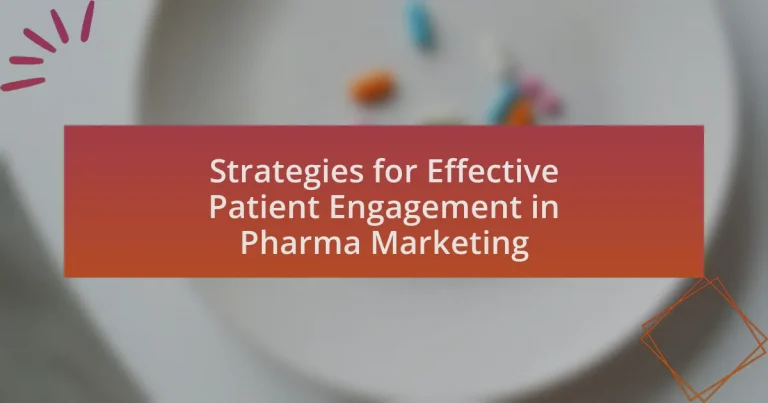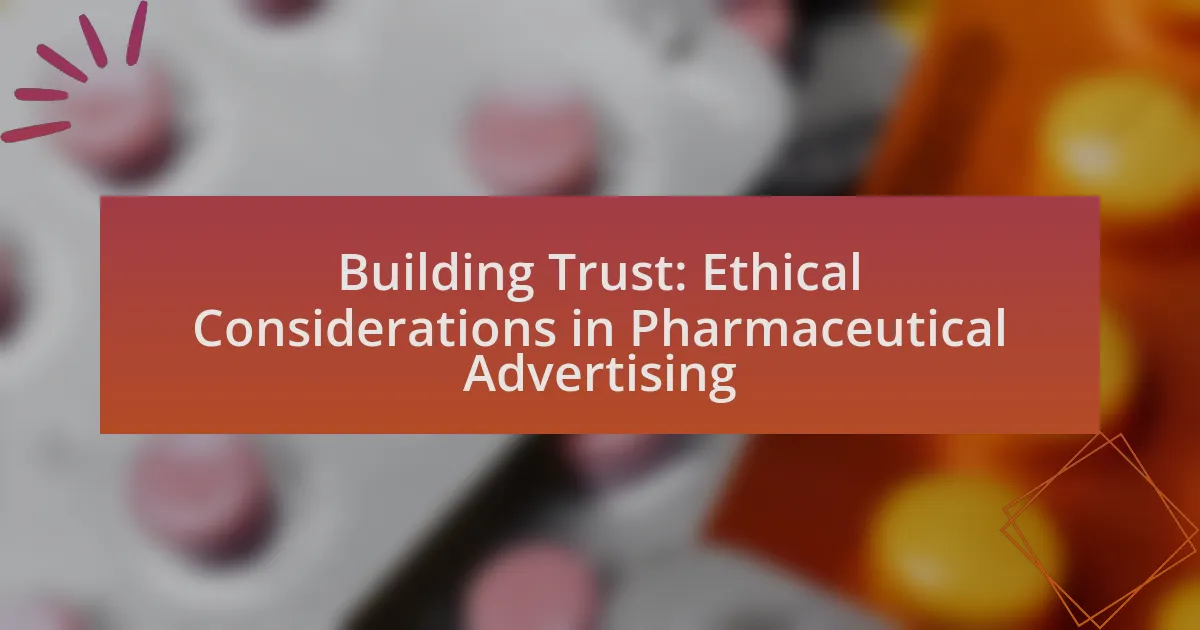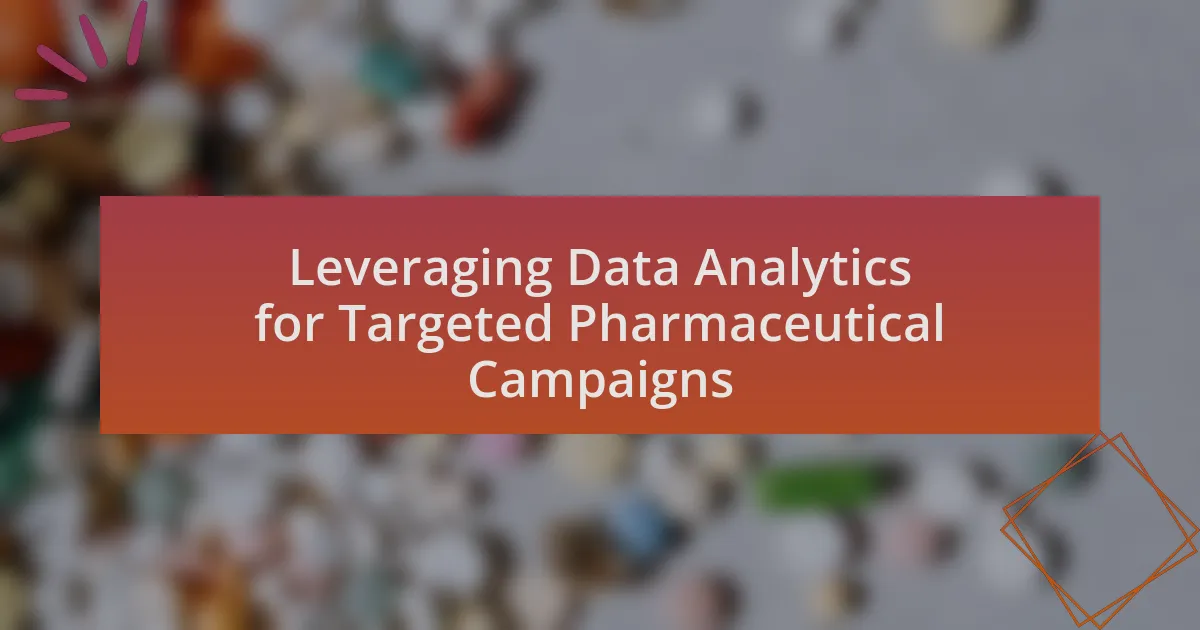The article focuses on strategies for effective patient engagement in pharmaceutical marketing, emphasizing the importance of personalized communication, digital platform utilization, and community support. It outlines methods for identifying target patient populations through data analytics and segmentation techniques, while also discussing the role of technology in enhancing patient-provider communication. Key challenges such as regulatory restrictions and diverse patient needs are addressed, along with best practices for creating a patient-centric culture and measuring engagement success through various metrics. The article provides a comprehensive overview of how pharma companies can improve patient adherence and satisfaction by implementing tailored engagement strategies.
What are the key strategies for effective patient engagement in pharma marketing?
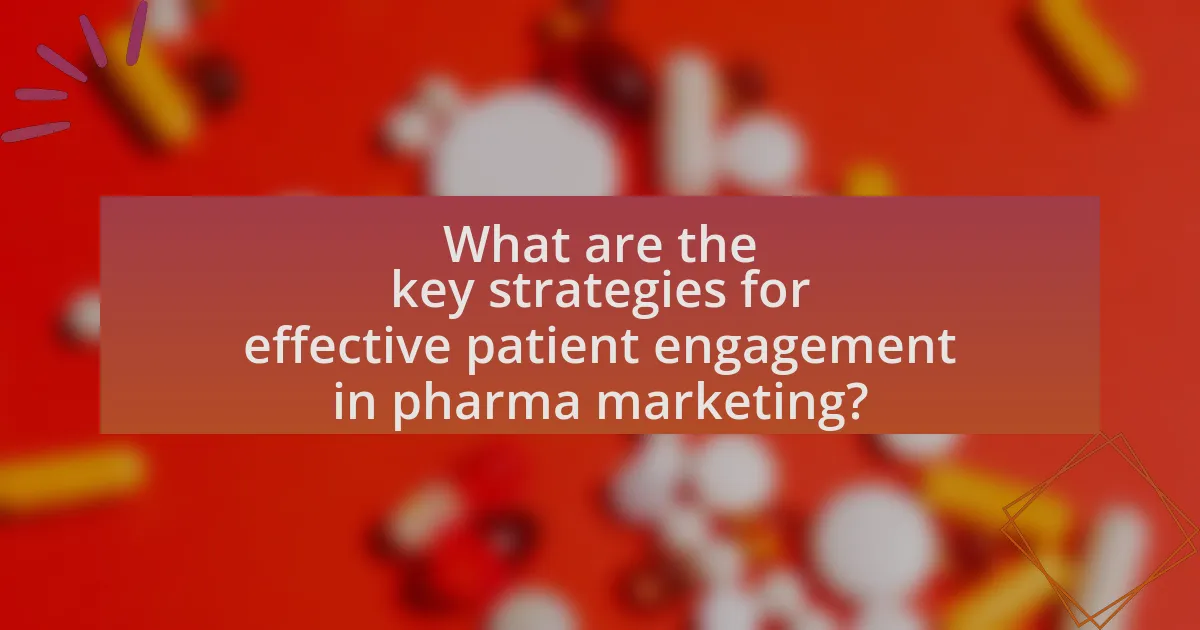
Key strategies for effective patient engagement in pharma marketing include personalized communication, leveraging digital platforms, and fostering community support. Personalized communication enhances the relevance of messages, as studies show that tailored content increases patient response rates by up to 50%. Utilizing digital platforms, such as social media and mobile apps, allows for real-time interaction and access to information, which is crucial since 80% of patients prefer online resources for health information. Additionally, fostering community support through patient advocacy groups and forums creates a sense of belonging and trust, which is essential for patient adherence and satisfaction.
How can pharma companies identify their target patient populations?
Pharma companies can identify their target patient populations by utilizing data analytics, market research, and patient segmentation techniques. Data analytics allows companies to analyze large datasets, including electronic health records and claims data, to identify demographic and clinical characteristics of potential patients. Market research, through surveys and focus groups, provides insights into patient needs and preferences. Patient segmentation techniques further refine these insights by categorizing patients based on specific criteria such as disease state, treatment history, and socio-economic factors. This multi-faceted approach ensures that pharma companies can effectively target and engage the right patient populations for their products.
What methods can be used to segment patient populations effectively?
Effective methods to segment patient populations include demographic segmentation, psychographic segmentation, geographic segmentation, and behavioral segmentation. Demographic segmentation categorizes patients based on age, gender, income, and education, allowing for targeted marketing strategies. Psychographic segmentation focuses on patients’ lifestyles, values, and attitudes, which can influence their healthcare decisions. Geographic segmentation divides patients based on their location, enabling tailored approaches that consider regional healthcare access and preferences. Behavioral segmentation analyzes patients’ interactions with healthcare services, such as medication adherence and treatment history, to identify specific needs and improve engagement. These methods are supported by data analytics and market research, which provide insights into patient characteristics and behaviors, enhancing the effectiveness of marketing strategies in the pharmaceutical industry.
How does understanding patient demographics influence engagement strategies?
Understanding patient demographics significantly influences engagement strategies by enabling tailored communication and outreach efforts. When pharmaceutical marketers analyze demographic data such as age, gender, ethnicity, and socioeconomic status, they can create targeted campaigns that resonate with specific patient groups. For instance, research indicates that younger patients may prefer digital engagement methods, while older patients might respond better to traditional communication channels. This targeted approach enhances the effectiveness of marketing strategies, leading to improved patient engagement and adherence to treatment plans.
What role does technology play in patient engagement?
Technology plays a crucial role in patient engagement by facilitating communication, enhancing access to information, and enabling personalized care. Digital tools such as mobile health applications, telemedicine platforms, and patient portals empower patients to manage their health actively, track their conditions, and communicate with healthcare providers efficiently. For instance, a study published in the Journal of Medical Internet Research found that patients using mobile health apps reported higher levels of engagement and satisfaction with their care. This demonstrates that technology not only improves the flow of information but also fosters a collaborative relationship between patients and healthcare professionals, ultimately leading to better health outcomes.
How can digital tools enhance communication with patients?
Digital tools enhance communication with patients by providing real-time access to information and facilitating direct interactions. These tools, such as telehealth platforms, mobile health applications, and patient portals, enable healthcare providers to share educational resources, appointment reminders, and treatment updates efficiently. For instance, a study published in the Journal of Medical Internet Research found that patients using mobile health apps reported improved communication with their healthcare providers, leading to better adherence to treatment plans. This evidence demonstrates that digital tools not only streamline communication but also foster a more engaged and informed patient population.
What are the benefits of using mobile apps for patient engagement?
Mobile apps enhance patient engagement by providing convenient access to health information and facilitating communication with healthcare providers. These applications enable patients to manage appointments, receive medication reminders, and track their health metrics, which can lead to improved adherence to treatment plans. Research indicates that patients using mobile health apps report higher satisfaction levels and better health outcomes, as evidenced by a study published in the Journal of Medical Internet Research, which found that 70% of users experienced increased engagement in their health management. Additionally, mobile apps can foster a sense of community among patients, allowing them to share experiences and support each other, further enhancing their engagement in the healthcare process.
Why is personalized communication important in pharma marketing?
Personalized communication is important in pharma marketing because it enhances patient engagement and improves treatment adherence. By tailoring messages to individual patient needs and preferences, pharmaceutical companies can foster stronger relationships and trust, leading to better health outcomes. Research indicates that personalized marketing strategies can increase patient response rates by up to 50%, demonstrating their effectiveness in capturing attention and driving action. This approach not only addresses specific health concerns but also aligns with the growing demand for patient-centric care in the healthcare industry.
How can personalized messaging improve patient adherence to treatment?
Personalized messaging can significantly improve patient adherence to treatment by tailoring communication to individual patient needs and preferences. This approach fosters a stronger connection between healthcare providers and patients, making patients feel understood and valued. Research indicates that personalized interventions can lead to a 20% increase in adherence rates, as patients are more likely to follow treatment plans when they receive relevant information that resonates with their specific circumstances. By utilizing data analytics to segment patients and customize messages, healthcare providers can effectively address barriers to adherence, such as misunderstanding treatment instructions or lack of motivation.
What techniques can be used to tailor messages to individual patients?
Techniques to tailor messages to individual patients include segmentation, personalization, and the use of patient data analytics. Segmentation involves categorizing patients based on demographics, health conditions, and behaviors, allowing for targeted messaging that resonates with specific groups. Personalization enhances engagement by customizing content to reflect individual patient preferences, treatment history, and communication styles. Patient data analytics leverages insights from electronic health records and patient feedback to refine messaging strategies, ensuring relevance and effectiveness. These techniques have been shown to improve patient adherence and satisfaction, as evidenced by studies indicating that personalized communication can lead to a 20% increase in treatment compliance.
How can pharma companies measure the effectiveness of patient engagement strategies?
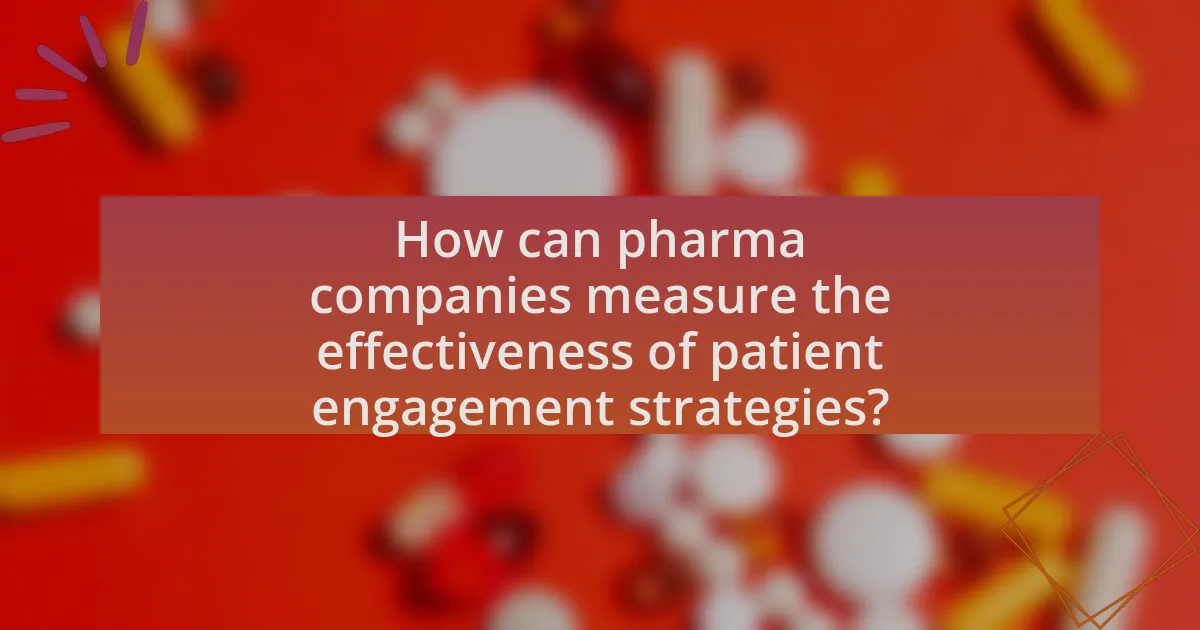
Pharma companies can measure the effectiveness of patient engagement strategies through metrics such as patient adherence rates, patient satisfaction surveys, and health outcomes data. By analyzing adherence rates, companies can determine how well patients follow prescribed treatments, which reflects engagement levels. Patient satisfaction surveys provide direct feedback on the engagement initiatives, allowing companies to assess the perceived value and effectiveness of their strategies. Additionally, tracking health outcomes, such as improvements in disease management or quality of life, offers concrete evidence of the impact of engagement efforts. These metrics collectively provide a comprehensive view of the effectiveness of patient engagement strategies in the pharmaceutical sector.
What metrics should be used to evaluate patient engagement success?
To evaluate patient engagement success, metrics such as patient satisfaction scores, adherence rates, and participation in health programs should be utilized. Patient satisfaction scores, often gathered through surveys, provide direct feedback on the patient experience and can indicate areas for improvement. Adherence rates measure how well patients follow prescribed treatment plans, reflecting their engagement and commitment to their health. Participation in health programs, such as educational workshops or support groups, demonstrates active involvement and interest in managing their health. These metrics collectively offer a comprehensive view of patient engagement effectiveness in the context of pharma marketing strategies.
How can patient feedback be collected and analyzed effectively?
Patient feedback can be collected and analyzed effectively through structured surveys, focus groups, and digital platforms. Structured surveys, such as those utilizing Likert scales, allow for quantifiable data collection, while focus groups provide qualitative insights into patient experiences. Digital platforms, including mobile apps and online forums, facilitate real-time feedback and broader reach.
Research indicates that 70% of patients prefer digital methods for providing feedback, highlighting the importance of integrating technology in the feedback process. Additionally, employing data analytics tools can enhance the analysis of collected feedback, enabling healthcare providers to identify trends and areas for improvement. This combination of methods ensures comprehensive understanding and actionable insights from patient feedback.
What role do patient surveys play in measuring engagement outcomes?
Patient surveys play a crucial role in measuring engagement outcomes by providing direct feedback from patients regarding their experiences and satisfaction with healthcare services. These surveys enable healthcare providers and pharmaceutical companies to assess the effectiveness of their engagement strategies, identify areas for improvement, and tailor their approaches to better meet patient needs. Research indicates that organizations utilizing patient feedback through surveys can enhance patient satisfaction scores by up to 20%, demonstrating the tangible impact of this data on engagement outcomes.
How can data analytics improve patient engagement efforts?
Data analytics can significantly enhance patient engagement efforts by providing insights into patient behaviors and preferences. By analyzing data from various sources, such as electronic health records and patient surveys, healthcare providers can identify trends and tailor communication strategies to meet individual patient needs. For instance, a study published in the Journal of Medical Internet Research found that personalized communication based on data analytics led to a 30% increase in patient adherence to treatment plans. This demonstrates that leveraging data analytics not only fosters better understanding of patient demographics but also improves overall engagement and health outcomes.
What types of data are most valuable for understanding patient behavior?
Quantitative data, qualitative data, and behavioral data are the most valuable types for understanding patient behavior. Quantitative data includes metrics such as medication adherence rates, appointment attendance, and health outcomes, which provide measurable insights into patient actions. Qualitative data, gathered through surveys, interviews, and focus groups, offers deeper understanding of patient motivations, preferences, and experiences. Behavioral data, derived from digital interactions, such as website visits and social media engagement, reveals patterns in how patients seek information and make decisions regarding their health. Collectively, these data types enable healthcare providers and pharmaceutical marketers to tailor strategies that effectively engage patients and improve health outcomes.
How can predictive analytics be used to enhance engagement strategies?
Predictive analytics can enhance engagement strategies by analyzing historical data to forecast patient behaviors and preferences. By leveraging algorithms and statistical models, pharmaceutical companies can identify trends in patient interactions, allowing for personalized communication and targeted marketing efforts. For instance, a study by McKinsey & Company found that organizations using predictive analytics in their marketing strategies saw a 10-20% increase in customer engagement rates. This data-driven approach enables companies to tailor their messaging and outreach, ultimately improving patient satisfaction and adherence to treatment plans.
What are the challenges faced in patient engagement within pharma marketing?
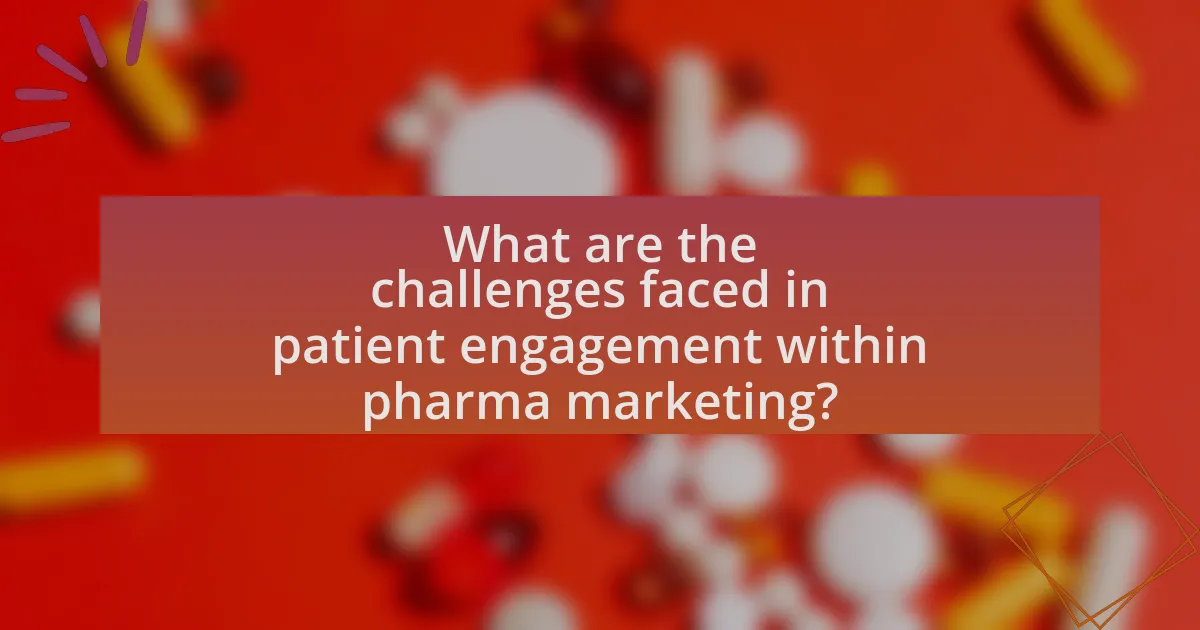
The challenges faced in patient engagement within pharma marketing include regulatory restrictions, diverse patient needs, and the complexity of healthcare information. Regulatory restrictions limit the ways pharmaceutical companies can communicate with patients, often hindering direct engagement efforts. Diverse patient needs create difficulties in tailoring messages and strategies to resonate with various demographics, leading to ineffective communication. Additionally, the complexity of healthcare information can overwhelm patients, making it challenging for them to engage meaningfully with the content provided by pharma companies. These factors collectively impede effective patient engagement strategies in the pharmaceutical industry.
What barriers exist to effective patient engagement?
Barriers to effective patient engagement include lack of health literacy, limited access to technology, and insufficient communication from healthcare providers. Health literacy affects patients’ ability to understand medical information, leading to disengagement; studies show that nearly 90 million adults in the U.S. struggle with health literacy, impacting their health outcomes. Limited access to technology, particularly among older adults and low-income populations, restricts their ability to engage with digital health tools. Additionally, insufficient communication from healthcare providers can result in patients feeling uninformed and unsupported, as evidenced by surveys indicating that 60% of patients desire more information about their conditions and treatment options.
How can pharma companies overcome skepticism from patients?
Pharma companies can overcome skepticism from patients by enhancing transparency and fostering trust through clear communication. By providing accessible information about drug development processes, clinical trial results, and potential side effects, companies can demystify their products. Research indicates that 70% of patients are more likely to trust pharmaceutical companies that openly share clinical trial data and outcomes. Additionally, engaging patients through personalized communication and addressing their concerns directly can further build rapport and credibility.
What strategies can be employed to address privacy concerns?
To address privacy concerns in pharma marketing, organizations can implement strategies such as data anonymization, robust consent mechanisms, and transparent communication. Data anonymization involves removing personally identifiable information from datasets, which minimizes the risk of privacy breaches while still allowing for valuable insights. Robust consent mechanisms ensure that patients are fully informed about how their data will be used and have the option to opt-in or opt-out, thereby enhancing trust. Transparent communication about data practices fosters a culture of openness, allowing patients to understand their rights and the measures taken to protect their information. These strategies collectively help mitigate privacy risks while engaging patients effectively.
How can collaboration with healthcare providers enhance patient engagement?
Collaboration with healthcare providers enhances patient engagement by fostering trust and improving communication between patients and their care teams. When healthcare providers actively involve patients in their treatment plans and decision-making processes, patients are more likely to feel valued and empowered. Research indicates that patient engagement can lead to better health outcomes; for instance, a study published in the Journal of Medical Internet Research found that effective communication and collaboration with healthcare providers significantly increased patient adherence to treatment regimens. This collaborative approach not only improves patient satisfaction but also encourages patients to take an active role in managing their health, ultimately leading to more successful healthcare experiences.
What are the benefits of partnerships between pharma companies and healthcare professionals?
Partnerships between pharmaceutical companies and healthcare professionals enhance patient engagement and improve health outcomes. These collaborations facilitate the sharing of valuable insights, allowing pharma companies to develop targeted therapies that meet the specific needs of patients. For instance, healthcare professionals provide real-world feedback on drug efficacy and safety, which can inform clinical trials and product development. Additionally, such partnerships often lead to educational initiatives that empower healthcare providers with the latest information on treatment options, ultimately benefiting patient care. Studies have shown that when healthcare professionals are involved in the development and marketing of pharmaceutical products, there is a higher likelihood of successful adoption and adherence among patients, as evidenced by improved patient satisfaction scores and health metrics.
How can education initiatives improve patient-provider communication?
Education initiatives can improve patient-provider communication by equipping both parties with essential knowledge and skills. These initiatives can include training programs for healthcare providers that focus on effective communication techniques, cultural competency, and active listening skills, which enhance their ability to understand and address patient concerns. For patients, educational resources that clarify medical terminology, treatment options, and health literacy empower them to engage more effectively in their care. Research indicates that when patients are better informed, they are more likely to ask questions and express their needs, leading to improved satisfaction and health outcomes. A study published in the Journal of Health Communication found that enhanced patient education significantly increased patient engagement and satisfaction with healthcare services.
What best practices should be followed for successful patient engagement?
Successful patient engagement requires clear communication, personalized interactions, and the use of technology to facilitate access to information. Clear communication ensures that patients understand their treatment options and health conditions, which can lead to better adherence to prescribed therapies. Personalized interactions, such as tailored educational materials and support programs, enhance the relevance of the information provided to patients, making them feel valued and understood. The integration of technology, such as mobile health applications and telehealth services, allows patients to access resources and communicate with healthcare providers conveniently, thereby improving their overall experience and engagement. These practices are supported by studies indicating that effective communication and personalized care significantly improve patient satisfaction and health outcomes.
How can pharma companies create a patient-centric culture?
Pharma companies can create a patient-centric culture by actively involving patients in the decision-making processes related to drug development and marketing strategies. This involvement can be achieved through initiatives such as patient advisory boards, where patients provide insights on their needs and preferences, ensuring that products and services align with their expectations. Research indicates that companies that engage patients in this manner not only improve patient satisfaction but also enhance the overall effectiveness of their marketing strategies, as evidenced by a study published in the Journal of Medical Marketing, which found that patient involvement leads to a 30% increase in product acceptance rates.
What are the key elements of an effective patient engagement plan?
An effective patient engagement plan includes clear communication, personalized care, and active participation. Clear communication ensures that patients understand their health conditions and treatment options, which is supported by studies showing that effective communication improves patient satisfaction and adherence to treatment. Personalized care tailors interventions to meet individual patient needs, enhancing their experience and outcomes, as evidenced by research indicating that personalized approaches lead to better health results. Active participation encourages patients to take an active role in their healthcare decisions, which has been linked to improved health outcomes and increased patient satisfaction. These elements collectively foster a collaborative relationship between patients and healthcare providers, ultimately leading to better health management.
